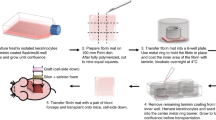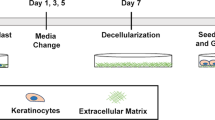Abstract
Keratinocytes were cultured on fibroblast-free dermal substitutes made of type I collagen film (collagen dermal substitute) and an extracellular matrix gel film (matrix dermal substitute), each of which was laid on a lyophilized type I collagen sponge. The morphology of the basal keratinocytes in these three-dimensional culture models of the skin was studied ultrastructurally and immunohistochemically to assess their differentiation to basal cells. The basal keratinocytes in the artificial epidermis cultured on the collagen dermal substitute showed poorly organized tonofibril networks and desmosomes. Neither the tonofibril-hemidesmosome complex nor the lamina densa were detected along the interface, where many cytoplasmic projections of basal keratinocytes were noted. There were no detectable antigens of type IV or VII collagen, LDA-1, or laminin in the interface. Bullous pemphigoid (BP) and 1-2B7B antigens and integrins were expressed along the cytoplasmic membrane and the projections of the basal keratinocytes. A high molecular weight keratin (keratin 1, 68 kDa, 34ΒB4) was detected only in part of the uppermost layers of this artificial epidermis. In contrast, basal keratinocytes in the artificial epidermis on the matrix dermal substitute developed tonofibril networks radiating to desmosomes and hemidesmosomes, under which a primitive lamina densa was present. Basement membrane zone antigens, such as type IV and VII collagens, LDA-1 and laminin were noted along the interface as were 1-2B7B and BP antigens and integrins. Laminin and type VII collagen were also detected along or in the membrane of the endoplasmic reticulum of basal keratinocytes. The high molecular weight keratin was detected in the suprabasal layers of this artificial epidermis, but the basal keratinocytes lacked expression of this epitope as does epidermis in vivo. The artificial epidermis cultured on the matrix dermal substitute had a basal layer of keratinocytes that could be characterized as basal cells, forming junctional structures resembling those of epidermis in vivo.
Similar content being viewed by others
References
Bell E, Ehrlich HP, Buttle DJ, Nakatsuji T (1981) Living tissue formed in vitro and accepted as skin-equivalent tissue of full thickness. Science 211: 1052–1054
Bell E, Sher S, Hull B, Merrill C, Rosen S, Chamson A, Asselineau D, Dubertret L, Coulomb B, Lapiere C, Nusgens B, Neveux Y (1983) The reconstitution of living skin. J Invest Dermatol 81: 2s-10s
Regnier M, Darmon M (1989) Human epidermis reconstructed in vitro: a model to study keratinocyte differentiation and its modulation by retinoic acid. In Vitro Cell Dev Biol 25: 1000–1008
Grinnell F, Toda K-I, Lamke-Seymour C (1987) Reconstitution of human epidermis in vitro is accompanied by transient activation of basal keratinocyte spreading. Exp Cell Res 172: 439–449
Hansbrough JF, Boyce ST, Cooper ML, Foreman TJ (1989) Burn wound closure with cultured autologous keratinocytes and fibroblasts attached to a collagen-glycosaminoglycan substrate. J Am Med Assoc 262: 2125–2130
Yannas IV, Lee E, Orgill DP, Skrabut EM, Murphy GF (1989) Synthesis and characterization of a model extracellular matrix that induces partial regeneration of adult mammalian skin. Proc Natl Acad Sci USA 86: 933–937
Coulomb B, Saiag P, Bell E, Breitburd F, Lebreton C, Heslan M, Dubertret L (1986) A new method for studying epidermalization in vitro. Br J Dermatol 114: 91–101
Schafer IA, Kovach M, Price RL, Fratianne RB (1991) Human keratinocytes cultured on collagen gels form an epidermis which synthesizes bullous pemphigoid antigens and α2Β1 integrins and secretes laminin, type IV collagen, and heparan sulfate proteoglycan at the basal cell surface. Exp Cell Res 195: 443–457
Bosca AR, Tinois E, Faure M, Kanitakis J, Roche P, Thivolet J (1988) Epidermal differentiation of human skin equivalents after grafting onto nude mice. J Invest Dermatol 91: 136–141
Tinois E, Tiollier J, Gaucherand M, Duma H, Tardy M, Thivolet J (1991) In vitro and post-transplantation differentiation of human keratinocytes grown on the human type IV collagen film of a bilayered dermal substitute. Exp Cell Res 193: 310–319
Lillie JH, MacCallum DK, Jepsen A (1988) Growth of stratified squamous epithelium on reconstituted extracellular matrices: long-term culture. J Invest Dermatol 90: 100–109
Yannas IV, Burke JF (1980) Design of an artificial skin. I. Basic design principles. J. Biomed Mater Res 14: 65–81
Yannas IV, Burke JF, Gordon PL, Huang C, Rubebstein RH (1980) Design of an artificial skin. II. control of chemical composition. J Biomed Mater Res 14: 107–132
Dagalakis N, Flink J, Stasikelis P, Burke JF, Yannas IV (1980) Design of an artificial skin. part III. control of pore structure. J Biomed Mater Res 14: 511–528
Suzuki S, Matsuda K, Isshiki N, Tamada Y, Yoshioka K, Ikada Y (1990) Clinical evaluation of a new bilayer “artificial skin” composed of collagen sponge and silicone layer. Br J Plast Surg 43: 47–54
Maruguchi T, Maruguchi Y, Suzuki S, Matsuda Y, Isshiki N (1992) Culture of keratinocytes on artificial skin dermis (collagen sponge). J Jpn Plast Reconst Surg 12: 73–82
Kleinman HK, McGarvey ML, Liotta LA, Roby PG, Tryggvason K, Martin GR (1982) Isolation and characterization of type IV procollagen, laminin, and heparan sulfate proteoglycan from the EHS sarcoma. Biochemistry 21: 6188–6193
Zhang X-M, Horiguchi Y, Ueda M, Yoshiki T, Imamura S (1991) 1-2B7B: monoclonal antibody reacting to the 120 kDa polypeptide component of human epidermal hemidesmosomes. Arch Dermatol Res 283: 310–316
Fine J-D, Gay S (1986) LDA-1: a ubiquitous noncollagenous lamina densa component of basement membrane detected by monoclonal antibody technique. J Invest Dermatol 86: 286–289
Engvall E, Davis GE, Dickerson K, Ruoslahti E, Varon S, Manthorpe M (1986) Mapping of domains in human laminin using monoclonal antibodies: localization of the neurite-promoting site. J Cell Biol 103: 2457–2465
Leigh IM, Eady RAJ, Haegerty AHM, Purkis PE, Whitehead PA, Burgeson RE (1988) Type VII collagen is a normal component of epidermal basement membrane, which shows altered expression in recessive dystrophic epidermolysis bullosa. J Invest Dermatol 90: 639–642
Tanaka T, Takahashi K, Furukawa F, Imamura S (1992) Molecular cloning and characterization of type VII collagen cDNA. Biochem Biophys Res Commun 183: 958–963
Eto H, Hashimoto K, Kobayashi H, Matsumoto M, Kanzaki T, Mehregan AH, Weiss RA (1985) Monoclonal antikeratin antibody: production, characterization, and immunohistochemical application. J Invest Dermatol 84: 404–409
Tsujimura K, Park Y-H, Miyama-Inaba M, Meguro T, Ohno T, Ueda M, Masuda T (1990) Comparative studies on FcR (FcRII, FcRIII, and FcRa) functions of murine B cells. J Immunol 144: 4571–4578
Contard P, Bartel RL, Jacobs II L, Perlish JS, MacDonald II ED, Handler L, Cone D, Fleischmajer P (1993) Culturing keratinocytes and fibroblasts in a three-dimensional mesh results in epidermal differentiation and formation of a basal lamina-anchoring zone. J Invest Dermatol 100: 35–39
Author information
Authors and Affiliations
Rights and permissions
About this article
Cite this article
Horiguchi, Y., Maruguchi, T., Maruguchi, Y. et al. Ultrastructural and immunohistochemical characterization of basal cells in three-dimensional culture models of the skin. Arch Dermatol Res 286, 53–61 (1994). https://doi.org/10.1007/BF00375844
Received:
Issue Date:
DOI: https://doi.org/10.1007/BF00375844




